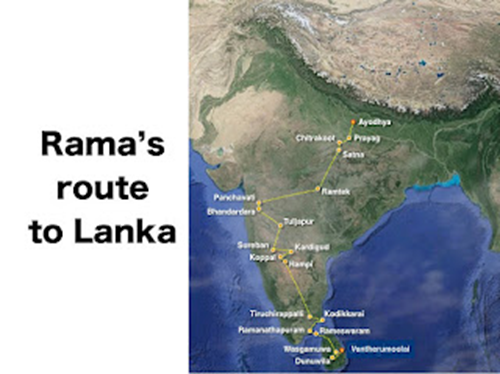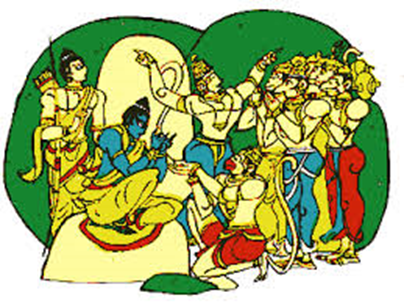Sri Rama while roaming in Dandaka Forest, alongwith Sita and Lakshmana, spent 10 years, out of 14 years of exile period.
“While Raghava stayed comfortably taking
delight in those hermitages of sages, indeed ten years have
smoothly elapsed”.
Thereafter, Sri Rama requests Sage
Agastya to indicate a place in the forest to make a residence during the remaining
days of exile. Sage Agastya informs Sri Rama to proceed to Panchavati, near
river Godavari, where Seetha will be delightful of its surroundings.
Sri Rama spent 3 years at Panchavati and in beginning of the last year Ravana
abducted Sita. Hence, Sri Rama spent the
ramaining 14th year in search of Seeta, befriending Sugriva at
Rishyamuka mountain, spending some time in Kishkinda, starting his war
expedition towards Ravana’s Lanka from Kishkinda and finally in fighting with
Ravana in Lanka.
-------
A crucial
question arise as to where the Panchavati and Kishkinda were situated at.
--------
Many
scholars/devotees of Sri Rama declared different route maps, depicting Sri
Rama's journey during the exile period of 14 years.
a) The most popular one, considering Panchavati as situated on the
left banks of sacred river Godavari in Nashik city, was pasted below.
b) In Southern India, it was strongly believed that, Panchavati was
situated near Parnasala at Bhadrachalam in Telangana State of India.
So whether it was from Panchavati in Maharashtra State or Parnasala in Telangana State, after Sita's abduction in the 14th year, it can be understood from Valmiki’s Ramayana that Sri Rama and Lakshmana crossed River Godavari and finally reached Kishkinda.
-----------------------
Sage Valmiki did not clearly mention as to the position of Sage Suteekshna
in the Dandaka Forest. It was Sage Suteekshna, who gave directions to Sri
Rama to Sage Agastya's hermitage.
"On your going four yojana-s from this hermitage, oh, dear Rama, there is
the great and glorious hermitage of Agastya's brother on the southern
side."
"On going one yojana beyond, taking the southward course on the side of the forest clump you will find Agastya's hermitage."
Hence, Sri Rama travelled 5 yojanas ,i.e,, 65 Kms (13 x 5 ) in Southern direction for reaching Sage Agastya's hermitage.
------
Sage Agastya directed Sri Rama to dwell at Panchavati, which is nearer to his hermitage.
So Panchavati was nearly at a distance of two yojana-s ,ie., 26 Kms from Sage Agastya's hermitage. Therefore, we cannot exactly fix the place of Panchavati, taking clues from Srimad Ramayana, unless we are sure of the location of Sage Agastya's hermitage.
----------
After performing the last rites of the bird Jatayu, near Panchavati, Sri Rama
travels nearly 3 Krosa or 11 Kms distance before reaching Krauncha Forest.
ततः परम् जनस्थानात् त्रि क्रोशम् गम्य राघवौ |
क्रौंच अरण्यम् विविशतुः गहनम् तौ महौजसौ || ३-६९-५
ततः पूर्वेण तौ गत्वा त्रि क्रोसम् भ्रातरु तदा |
क्रौंचारण्यम् अतिक्रम्य मातंग आश्रम अंतरा || ३-६९-८
After having a fight with Kabandha, and upon his direction the 2 brothers
travelled in Western direction and reached Pampa and Rishyamuka mountain, where
Sugriva was hiding from Vali.
तम् तोलयित्वा बाहुभ्याम् गत सत्त्वम् अचेतनम् |
चिक्षेप वेगवान् वाली वेगेन एकेन योजनम् || ४-११-४७
"Then
the hastiest Vali swayed that dead and inanimate demon with both of his hands
and hurled him a yojana distance in a single flick.
----
Sri
Rama was in Kishkindha kingdom when Sri Hanuman brought the news of Sita being
alive in Lanka.
Sri
Rama started from Kishkindha kingdom in southern direction towards Ravana’s
Lanka and reached Sahya Mountain enroute to ocean.
ततः पादप सम्बाधम् नाना मृग समाकुलम् |
सह्य पर्वतम् आसेदुर् मलयम् च मही धरम् || ६-४-७२
The
question is as to why Sri Rama started from Karnataka and travelling in
southern direction reached Sahyadri in Maharashtra, which is Northern
direction?
Then
another Sahya mountain might have existed in Southern parts to the present day Karnataka
area.
(Or)
Kishkinda
might have been existed in the northern direction to the present-day
Maharashtra.
Again when sending the troops to Southern direction in search of Sita, Sugriva
orders them to start their search from Vindhya Mountains.
विधाय हरि वीराणाम् आदिशद् दक्षिणाम् दिशम् || ४-४१-६
नर्मदाम् च नदीम् रम्याम् महोरग निषेविताम् || ४-४१-८
------
Vindhya mountain runs north of and roughly parallel to the Narmada River in Madhya Pradesh. Depending on the definition, the range
extends up to Gujarat in the west, Uttar Pradesh and Bihar in the north, and Chhattisgarh in the east.
Narmada river flows through the states of Madhya Pradesh
and Gujarat in India.
------
Now a question arises,
if Kishkinda was in area of present day Karnataka state, why should Sugriva
ordered vaanaras to start their search from Vindhya mountains, which are
located in Madhya Pradesh area?
Any sane person will decide the 4 directions, ie., North, South, East and West,
according to his place only, but not somewhere else.
-------
Hence, Kishkinda might have have been located in the area of present day
Madhya Pradesh or Chattisgarh only, but not Karnataka state, as commonly
believed.
People of that era might be referring to the tributaries of Godavari river,ie., Wainganga, Indravati and Shabari rivers, as Godavari, which originate in Chattisgarh/Odissha
area and merges in river Godavari.
And, Panchavati might have existed along the banks of river Wainganga or Indravati or Sabari.




Great observation 👍
ReplyDelete